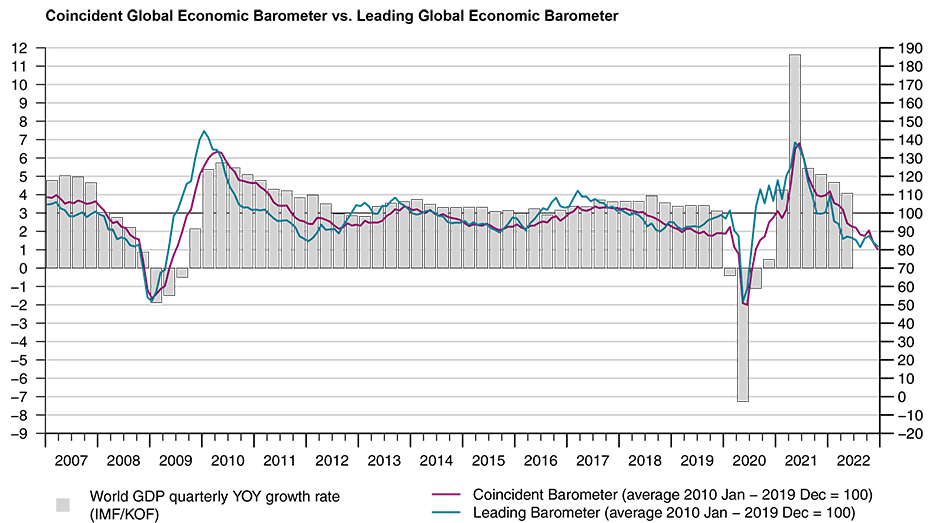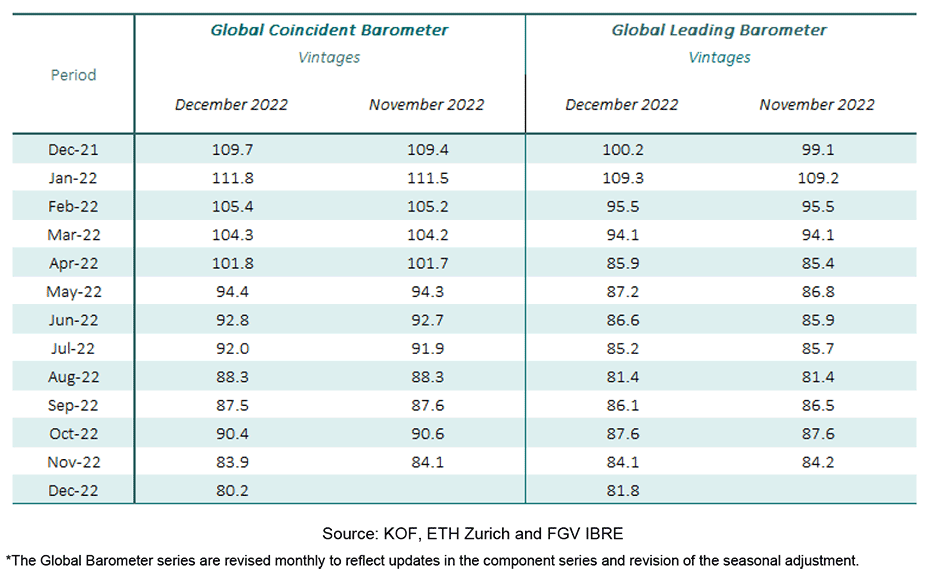Global Barometers: world slowdown continues
The Global Barometers continue to signal a clear world economic slowdown at the end of 2022. After a second successive fall, both indicators reach levels which – apart from the worst period of the COVID-19 crisis – have not been seen since the financial crisis in 2008/2009.

In December 2022, the Coincident Global Economic Barometer falls 3.7 points to 80.2 points, while the Leading Global Economic Barometer drops 2.3 points to 81.8. The decline in both indicators was mainly driven by the worsening of the economic environment in the Asia, Pacific & Africa region.
"For two months in a row now, the Asia, Pacific and Africa region is clearly the region that drags down both global barometers. This region has thus now approached the already prevailing low levels of the Europe and Western Hemisphere regions. Uncertainty about political and economic developments in China is likely to be the main cause. In Europe, on the other hand, the outlook is at least improving somewhat, albeit from a low level and still far from what can be considered as normal", evaluates Jan-Egbert Sturm, Director of KOF.
“For two months in a row now, the Asia, Pacific and Africa region is clearly the region that drags down both global barometers. This region has thus now approached the already prevailing low levels of the Europe and Western Hemisphere regions. Uncertainty about political and economic developments in China is likely to be the main cause.”Jan-Egbert Sturm
Coincident Barometer – regions and sectors
In December, the Asia, Pacific & Africa region contributes 3.5 points to the 3.7-point decrease in the Coincident indicator, while the Western Hemisphere contributes -0.3 points and Europe +0.1 point. The sharp decline in the Asia, Pacific & Africa region reflects, among other things, the consequences of the restrictions related to the ‘Zero Covid’ policy in China, which has led to a wave of protests. The continued low levels of the regional indicators constitute a negative scenario for economic growth for the coming months. The graph below illustrates the contribution of each region to the deviation of the Coincident Barometer from the historical mean of 100 points.
Among the coincident sector indicators, the Economy (aggregated business and consumer evaluations), Industry, and Trade decrease this month, while Services and Construction move in the opposite direction. All the sectorial indicators end 2022 far from the historic mean of 100 points and signal an economic slowdown spread across the sectors.
Leading Barometer – regions and sectors
The Leading Global Barometer leads the world economic growth rate cycle by three to six months on average. In December, only the Asia, Pacific & Africa region causes a further decline in the indicator, with -4.0 points. In contrast, the Western Hemisphere and Europe contribute positively with 1.6 and 0.1 points, respectively. The levels of the indicators nevertheless suggest an unfavourable development in the coming months.
Among the sectors, only the Services leading indicator does not decrease in December. All sectoral indicators signal a pessimistic outlook for the coming months.
The Global Economic Barometers
The Global Economic Barometers are a system of indicators enabling timely analysis of global economic development. They represent a collaboration between the KOF Swiss Economic Institute of the ETH Zurich in Switzerland and Fundação Getulio Vargas (FGV), based in Rio de Janeiro, Brazil. The system consists of two composite indicators, the Coincident Barometer and the Leading Barometer. The Coincident Barometer reflects the current state of economic activity, while the Leading Barometer provides a cyclical signal roughly six months ahead of current economic developments.
The two Barometers comprise the results of economic tendency surveys conducted in more than 50 countries with the aim of achieving the broadest possible global coverage. The advantages of economic tendency surveys are that their results are usually readily available and are not substantially revised after first publication.
The Coincident Barometer includes more than 1,000 different time series, while the Leading Barometer consists of over 600 time series. Cross-correlation analysis is used to decide which individual time series are included in the barometers. This involves correlating the individual time series with a reference series. The reference series used is the year-on-year growth rate of global gross domestic product (GDP), where the individual national GDPs are aggregated at purchasing power parity to form global GDP. A time series is only included in a Barometer if it shows a sufficiently high correlation and a suitable synchronization or lead with the reference series. The time period used for this correlation analysis currently runs from January 2010 to December 2019.
The series of the two Barometers are revised each month at publication and are standardized to have a mean of 100 and a standard deviation of 10 for the 10-year period previous to the most recent observations.
The methodology is described in:
Klaus Abberger, Michael Graff, Aloisio Jr. Campelo, Anna Carolina Lemos Gouveia, Oliver Müller and Jan-Egbert Sturm (2020), The Global Economic Barometers: Composite indicators for the world economy. KOF Working Papers, vol. 471, Zurich: KOF Swiss Economic Institute, ETH Zurich, 2020.
Contact
KOF Konjunkturforschungsstelle
Leonhardstrasse 21
8092
Zürich
Switzerland

